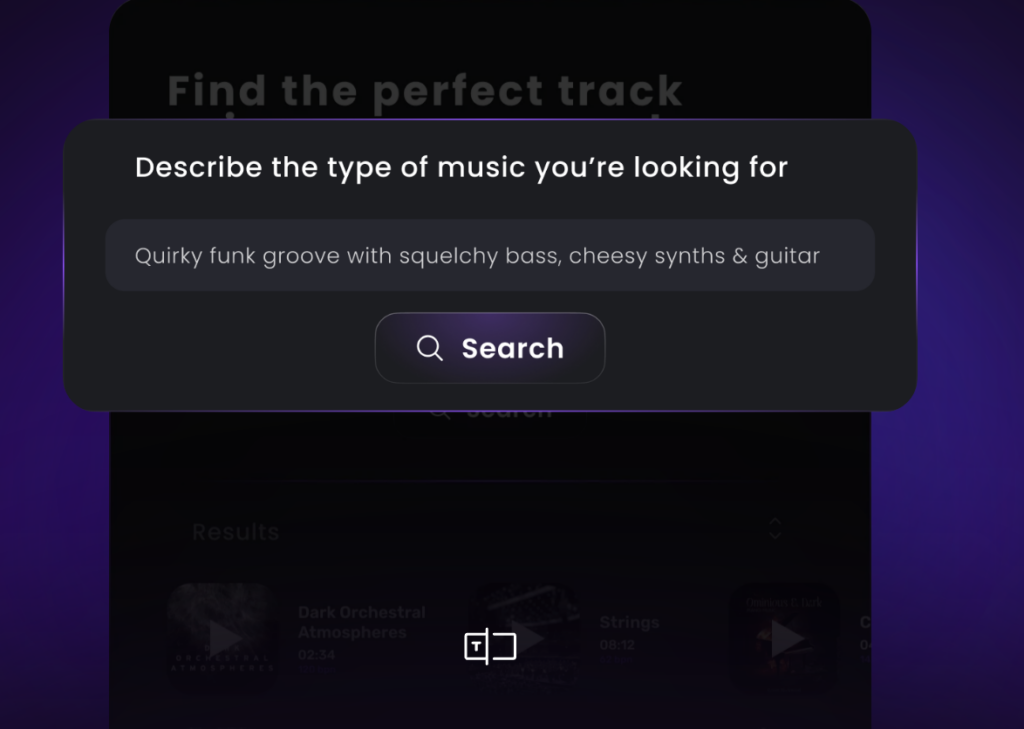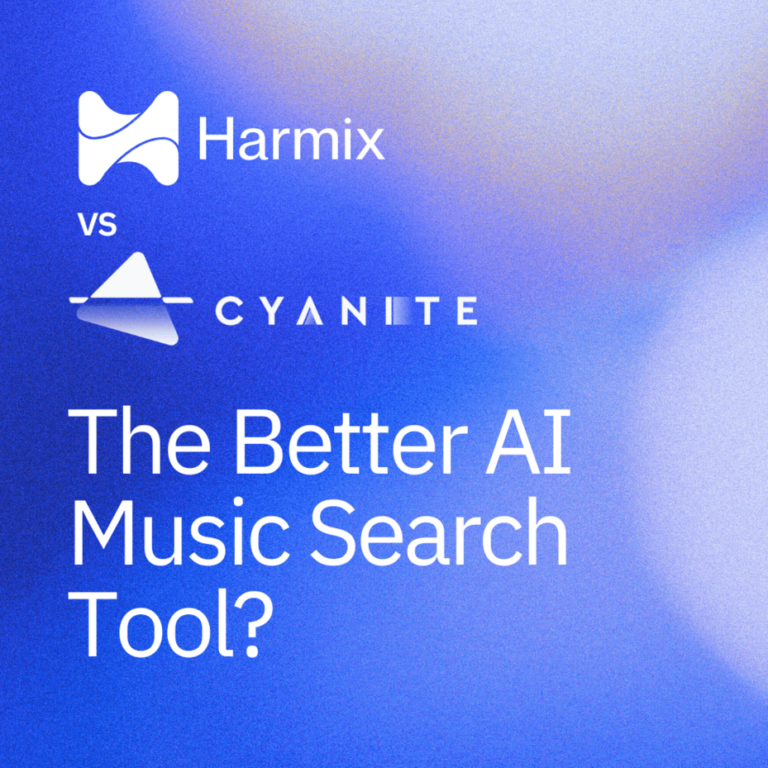Content creators and music supervisors turn to AI-powered solutions as traditional tag-based music searches become outdated. Two prominent tools in 2025 are Cyanite and Harmix, each offering distinct approaches to music discovery.
While Cyanite specializes in mood and genre-based matching with extensive auto-tagging capabilities, Harmix focuses on multi-modal search, including video-to-music matching.
Now the question is, Cyanite vs. Harmix, which one suits you?
Understanding the key differences between these tools is essential for teams managing music catalogs or creators needing quick, accurate track selection.
Let’s compare their features, use cases, and limitations to help you choose between Cyanite and Harmix.
What is Cyanite?

Cyanite is an AI-powered music analysis platform that helps music companies, publishers, and content creators organize and search through music catalogs more efficiently. The platform uses artificial intelligence to analyze audio files, generate detailed tags, and enable natural language search capabilities.
Key features of Cyanite
Some of the key features of Cyanite include:
Free text search
Similarity search
Auto-tagging
💡Learn more about Cyanite alternatives
What is Harmix?

Harmix is an AI-powered music search platform designed for production music companies, TV/movie productions, record labels, and publishers. The platform focuses on providing multiple search approaches, emphasizing visual content matching and private analysis capabilities.
Key features of Harmix
Some of the key features of Harmix include:
Prompt search
Similarity search
Segment-based search
💡Learn more about Harmix alternatives
Cyanite vs. Harmix: What are the Differences?
Understanding the differences between Cyanite and Harmix is crucial for finding the tool that best fits your workflow. Let’s focus on three key areas significantly impacting day-to-day usage: search capabilities, user experience, and target audience.
Here’s a quick comparison between Harmix and Cyanite at a glance:
| Feature | Cyanite | Harmix |
|---|---|---|
| Search Approach | Text-based natural language search, genre-focused, mood analysis | Visual-first approach, prompt-based search, segment matching |
| User Interface & Learning | Complex interface with a steep learning curve, extensive features require training | Streamlined interface focused on quick results, intuitive video upload |
| Primary Users | Music libraries, publishers, catalog managers | Video producers, content creators, sync teams |
Let’s learn about Harmix vs. Cyanite in detail:
Harmix vs. Cyanite: Search approach and capabilities
Cyanite approaches music search through deep audio analysis and natural language processing. The platform excels at understanding complex text descriptions and breaking down audio into detailed components like genre, mood, and instrumental elements. Its strength is processing detailed briefs like “energetic orchestral pieces with building tension and brass elements.”
The system relies heavily on its extensive genre classification (1,500+ genres) and mood detection capabilities, making it particularly effective for specific musical requirements.
Harmix takes a distinctly different approach with its visual-first strategy. The platform’s core strength is understanding the relationship between visual content and music, allowing users to upload video clips or images directly.
Rather than focusing on detailed musical analysis, it prioritizes matching visual content’s overall mood and energy. The segment-based search is particularly unique, letting users identify specific moments in videos that need musical matching. This makes it especially valuable for video editors and creators who start with visual content rather than musical requirements.
The key difference lies in their entry points – Cyanite starts with musical elements and text descriptions, while Harmix begins with visual content and emotional matching. This fundamentally affects how users interact with each platform and the types of results they receive.
Harmix vs. Cyanite: User interface and learning curve
Cyanite’s interface reflects its comprehensive approach to music analysis. Users face a steeper learning curve due to the platform’s extensive features and detailed control options. The interface presents multiple parameters for fine-tuning searches, including genre weights, mood sliders, and temporal characteristics.
While this offers precise control, new users often need several hours to understand the full capabilities. The platform includes detailed documentation and requires users to understand music terminology for optimal results.
Harmix prioritizes simplicity and visual workflow. Its interface centers around video upload and prompt input, with a straightforward process that feels familiar to content creators. The learning curve is notably gentler, with most users able to start getting valuable results within minutes. The platform abstracts complex musical analysis behind a simple drag-and-drop interface. However, this simplicity means less granular control over search parameters than Cyanite.
The fundamental difference in user experience stems from their target workflows – Cyanite optimizes for precision and control at the cost of complexity. At the same time, Harmix favors accessibility and speed over detailed customization.
Harmix vs. Cyanite: Target users and use cases
Cyanite caters primarily to music professionals managing large catalogs. Its users typically include music libraries, publishers, and professional catalog managers who need deep musical analysis and precise categorization. The platform’s detailed tagging and analysis features support tasks like catalog organization, metadata enrichment, and specific track selection for licensing. Users often spend significant time with the platform, using it as a core catalog management tool rather than just searching.
Harmix targets content creators and video producers who need quick, intuitive music selection. Its user base consists mainly of video editors, content creators, and sync teams working on tight deadlines. The platform excels in scenarios where visual content drives music selection, such as advertising, social media content, and video production. Users typically engage with the platform for specific projects rather than ongoing catalog management.
The key difference in target users is reflected in their feature priorities – Cyanite optimizes for comprehensive musical analysis and catalog management. At the same time, Harmix focuses on rapid visual-to-music matching and content creation workflows.
Introducing Beatoven.ai – A Great Alternative to both Harmix and Cyanite
While Cyanite and Harmix each offer distinct approaches to AI music search, Beatoven.ai emerges as a compelling alternative that addresses the typical limitations of both platforms. Let’s explore why Beatoven.ai’s Search API might be the solution you’re looking for.
Advanced natural language understanding
Unlike Cyanite’s dependency on audio quality or Harmix’s video-first approach, Beatoven.ai focuses on understanding user intent through natural language. The platform processes complex search queries without requiring perfect audio files or visual references.
Users can express their needs in everyday language, whether looking for “uplifting background music for a winter scene” or “energetic beats for a product launch.” This natural language processing capability makes music discovery more intuitive and accessible for all users.
Ethical AI and data usage
While other platforms use various data sources, Beatoven.ai stands out with its FairlyTrained certification, ensuring only licensed data is used in its AI model. This commitment to ethical AI practices results in more reliable and legally sound search results than competitors. The platform maintains high accuracy while respecting creator rights, making it a responsible choice for businesses concerned about data ethics and licensing.
Flexible integration options
Beatoven.ai’s Search API offers straightforward integration into existing music libraries, contrasting with Cyanite’s complex setup and Harmix’s video-dependent system. Platforms can implement free-text search without overhauling their current systems, and the API adapts seamlessly to different use cases and catalog sizes. This flexibility makes it ideal for businesses looking to enhance their search capabilities without significant technical overhead.
Continuous improvement model
Setting itself apart from static search systems, Beatoven.ai’s AI model learns and improves over time. Search accuracy increases with usage, unlike traditional tag-based systems used by competitors. The platform continuously gets better at understanding user intent and context, reducing the need for manual oversight. This adaptive capability ensures that the search functionality becomes more refined and accurate as your usage grows.
Here is how Beatoven.ai stands out in the Harmix vs. Cyanite battle:
| Feature | Beatoven.ai | Harmix | Cyanite |
|---|---|---|---|
| Search Accuracy | Natural language processing with continuous AI learning | Fixed visual-audio matching algorithm | Dependent on audio quality and tags |
| Data Ethics | FairlyTrained certified, uses only licensed data | Standard data processing | Standard data processing |
| Integration Ease | Simple API implementation with existing libraries | Requires CMS compatibility | Complex setup requiring technical expertise |
| Search Flexibility | Handles complex queries in any language without requiring specific inputs | Requires video/image input | Requires high-quality audio files |
| Scalability | Improves search accuracy with increased usage | Fixed performance model | Manual oversight is needed for large catalogs |
Harmix vs. Cyanite: Which One to Choose?
While both Cyanite vs. Harmix offers unique strengths – Cyanite’s detailed audio analysis and Harmix’s visual matching capabilities – your choice ultimately depends on your specific needs.
Cyanite suits teams requiring deep musical analysis, while Harmix works best for video-first workflows.
If you’re looking for a solution that combines natural language understanding with ethical AI practices and continuous improvement, Beatoven.ai’s Search API is your answer.
To know more:
FAQ
Is cyanite AI safe?
Yes, Cyanite processes data securely with servers located in the European Union and maintains GDPR compliance. Their algorithms are developed in-house without relying on external AI models.
What is cyanite used for?
Through AI-powered analysis, cyanite helps music companies and publishers organize and search music catalogs. It generates tags and descriptions and enables natural language search for efficient music discovery.
Can AI analyze music?
Yes, AI can analyze various aspects of music, including genre, mood, tempo, instruments, and lyrics. For better categorization, modern AI tools like Cyanite can break down audio files into detailed musical components.

Sreyashi Chatterjee is a SaaS content marketing consultant. When she is not writing or thinking about writing, she is watching Netflix or reading a thriller novel while sipping coffee.

